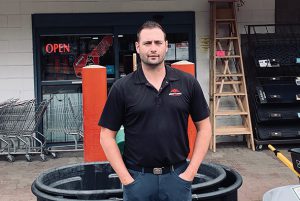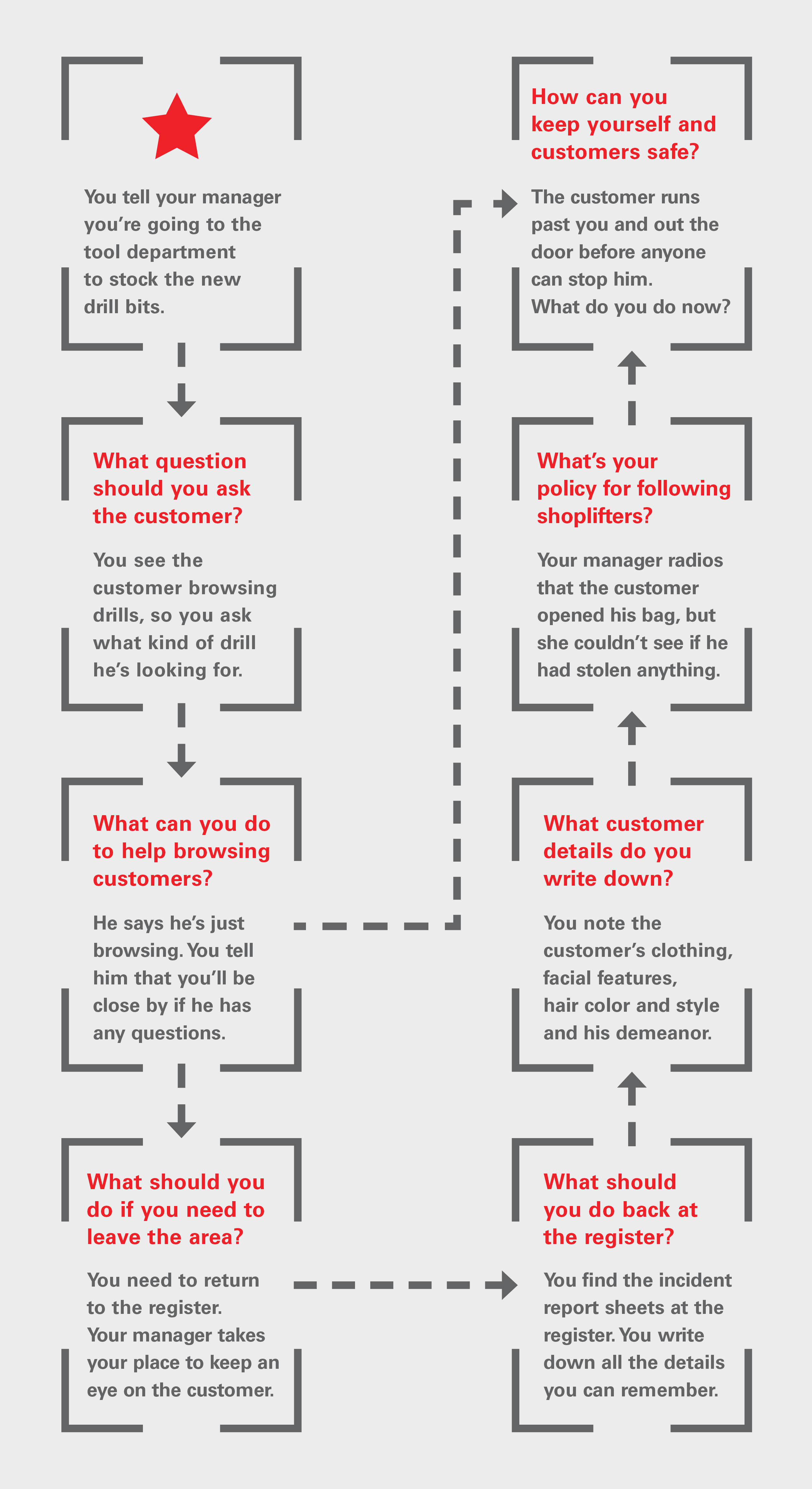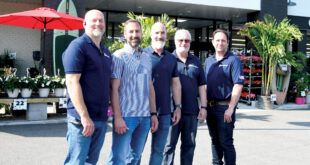Preventing loss at your business requires a holistic approach that involves everything from the customer service you provide on the salesfloor to the sophistication of the POS system that keeps track of your sales.
That approach is similar whether you are facing down a shoplifter or investigating a thief on your own staff.
In this article, Hardware Retailing takes a look at two retailers who have faced what may be extreme cases of criminal activity, both inside and outside their companies. Brandon Ford, manager at Albertsons Home Center in Parksville, British Columbia, discovered an employee had been stealing thousands of dollars through return fraud. Stephanie Van Ness, president and owner of Andy’s Ace Hardware in Anchorage, Alaska, has been dealing with a sharp spike in shoplifting.
Each of these retailers has tightened security at their stores. They’ve found that the best loss prevention tactics are based on using the latest technologies to catch criminals in the act paired with a consistent dose of old-fashioned customer service.
By reading what these two retailers have learned, you may spot areas where you can improve security at your own operation and shut down criminals before they can do their damage.
If you want more insights into loss prevention, check out a video from the Hardware Retailing archives at TheRedT.com/buchheit-security.
Case Study: Albertsons Home Center
Employee Theft

Albertsons Home Center manager Brandon Ford has a staff any retailer would idealize. The majority are full time, with many long-term employees, some with 15-year tenures. They work hard and care about the success of the company.
Still, there can always be an exception. That truth hit home hard two years ago when Ford discovered one of his trusted, full-time cashiers, Kim (not her real name), had been slowly stealing money from the company. Discovering Kim’s dishonesty was a watershed moment for Ford, forcing him to rethink employee accountability and oversight while preserving the company culture of trust that is so important to the success of his operation.
The Problem: Return Fraud
Ford’s first clue that something was wrong came after a phone call from one of his employees. A customer wanted to purchase an 8 ¼-inch circular saw. According to the store’s point-of-sale system, there should be one in stock, said the employee, but it wasn’t on the shelf. Puzzled, Ford did a quick search on the POS. A few days earlier, Kim had returned the saw in question.
That return raised a red flag, so Ford started digging deeper to see if Kim had made any other unusual returns. Kim had been with the company about four years, and Ford trusted her. She was going to school part time, and Ford was coaching her through her business class.
“We thought that after we helped her through school, we could create a position for her to develop her career,” he says.
Then more returns started showing up. With his POS software, Ford began looking for recent return invoices generated by Kim’s cashier ID and noticed a disturbing trend. Most of the returns were made with the same credit card. They were also mostly small dollar amounts with a high inventory count where it would be easy to overlook that an item was missing.
Ford cross-referenced the credit card number with a transaction Kim had made on her staff account. The cards matched. Ford got a report from his POS provider showing all returns Kim had made with her personal credit card. Over a nine-month period, Kim had processed more than $10,000 in fraudulent returns.
Ford’s next move was to call the police. After seeing the evidence, the officer agreed Ford had a case.
“When she arrived for her shift, the officer and I took her up to my office, and of course she denied everything,” he says. “But at that point, I terminated her employment, and the officer escorted her off the property.”
Fortunately, Ford carried internal theft insurance and recouped most of the money lost. The local government proceeded with a criminal prosecution and conviction because of the sizable dollar amount stolen. Ford was finished with the crime. Now he had to deal with the aftermath.
The Cleanup: Preserving the Team
“Every person in the company felt violated,” says Ford. “And it was critical for me to continue to have faith in our team.”
Ford had to work both inside and outside the company to divert further disaster. During the two years it took for the case to make its way through the court, Kim continued to deny any wrongdoing. Ford started hearing around town that he must have made this up just to get rid of Kim.
No one seemed to think she would do something like that.
“I decided it was best to take the high road and remain fairly tight-lipped about the whole incident,” he says. “We didn’t want the family to think we were gloating or coming after them. This is a small community, and I didn’t want to create divisions.”
While Ford decided it was important to be cautious about what he said to the community, he was more open with his staff.
“It was important to have complete transparency with my staff,” he says. “I told them, ‘I’m going to be on edge for a while. Don’t take it personally. It will take some time to deal with this.’”
Employees can tell when you are hiding the truth from them, so be honest and treat them like adults, he advises. Doing that will strengthen your relationship with them, it will promote a culture of trust, and it will go a long way to generate goodwill. Let your staff know you care about them, and more than likely, the feeling will be mutual.
“My birthday came up shortly after this incident,” he says. “I came into my office to find it packed with balloons and streamers. That gave us all the opportunity to have a good laugh in the morning and start trying to get back to normal.”
What You Can Do
![]() Ask Questions
Ask Questions
Ford runs a regular report that shows him return histories and alerts him to irregularities or worrisome patterns. Don’t be afraid to ask questions about even minor discrepancies in your records.
“Where there’s smoke, there’s fire. You might have to think like a criminal to catch a criminal. If you see something that’s off, investigate,” says Ford.
![]() Follow Up on Returns
Follow Up on Returns
Ford now collects more information with each return. Each return must include a reason for the return, along with the customer’s name and phone number.
“We might call a customer if something looks strange with the return,” he says. “We can also follow up and ask if there’s anything we can do better next time.”
![]() Empower Employees
Empower Employees
Ford’s investigation into this case started with a call from a concerned employee who understood the inventory procedure enough to realize something was amiss.
“Teach associates to understand the POS system, and tell them it’s important to raise a question when they see something that doesn’t make sense,” he says.
![]() Build the Team
Build the Team
Employees who don’t think you care about them may feel that you owe them, which may prompt some to steal. Even then, a trusted employee can change.
“The relationship is important,” Ford says. “If you know something is happening in a person’s life, then you can be more aware of how that might change their behavior.”
Case Study: Andy’s Ace Hardware
Shoplifting

Shoplifting at Andy’s Ace Hardware has spiked over the past few years. Company president and owner Stephanie Van Ness believes that rampant drug abuse in the area combined with a new state law, which weakened penalties for shoplifting, have made criminals bolder. While shoplifting was already a problem for area merchants, it’s gotten a lot worse.
“We are getting hit between two and four times a day,” she says.
That’s despite 100 security cameras surveilling the 20,000-square-foot store and locks on most of the high-value merchandise. She says the law is likely to be reversed soon, but there’s no guarantee what effect that will have on overall shoplifting rates. To cope, Van Ness has raised loss prevention awareness among all employees and boosted customer service levels so her store can continue to be a safe place to shop.
The Problem: Shoplifters
Battling shoplifting can be like trying to hit a moving target. It’s difficult to know what will be the next hot item that will get stolen. Smaller items have always been vulnerable, says Van Ness. She’s had to move much of the store’s smaller impulse items to the front register where they’re more visible to staff. Flashlights are frequently stolen, but sometimes the theft of larger items hits the store in a wave.
Thieves are different, too, and Van Ness has seen them all. One perpetrator cut the lock on a chainsaw, setting off the alarm. He made a dash for the back door, jumping over a pallet of soil and then a fence in a dramatic exit. Another criminal cut the chain securing a generator before returning to the store a couple of hours later to retrieve it.
Other potential shoplifters can be deterred, with patience. Van Ness says a tell-tale sign of a shoplifter is spending hours in the store while nervously watching the staff and filling a shopping cart only to abandon it and leave. More than likely, those customers intended to steal, but gave up thanks to the attention they received from the staff.
Some criminals just have less sense than others.
“One woman interviewed for a job here,” she says. “On her way out after the interview, she stole from us. Of course, we had all of her personal information. We invited the police to her second interview.”
The Cleanup: Managing Theft
Dealing with theft has become top of mind for every Andy’s Ace employee, every day. The store has a well-defined policy on how to deal with a shoplifter. Van Ness has one employee designated as the loss prevention officer who is the point person for all cases, but all staffers know how to spot potential shoplifters and fill out the necessary police reports.
Deterrence begins at the front door. Van Ness designates an employee as the customer coordinator who greets every customer at the front door. The position is non-negotiable, she says, meaning that employees cannot leave their post unless they have found someone to replace them, even if it’s for a brief break.
“That person is our eyes and ears on the salesfloor,” says Van Ness.
The store maintains a record, called the trespass book, of every theft incident. Thanks to a high-definition camera system, they have photos of everyone who has shoplifted. Employees are required to review that book frequently, so if the customer coordinator sees someone in the book returning to the store, they can pass the word to the rest of the staff. Staff shares information about potential shoplifters using code words.
Another employee monitors the cameras, so they can generally spot a suspicious customer trying to hide merchandise in their clothing or a bag. When it’s evident a shoplifter is on the move, Van Ness says their procedure is to wait until that person has passed the last point of purchase before taking action.
“Our No. 1 rule is to never put yourself in harm’s way,” she says.
Employee safety is always a top priority, and every situation is different. If they determine it’s safe to confront a shoplifter, they will detain them, fill out the forms and contact the police.
Other security measures throughout the store include an electronic keypad on the employee entrance at the back of the store. There’s a lock on the dumpster. Bathrooms are locked, but every night employees check them for empty boxes, usually evidence a shoplifter has been at work. After an armed robbery, Van Ness started closing the store an hour earlier in the evening, as there were a higher number of incidents occurring later in the evening.
“We’ve learned to just start doing everything better,” says Van Ness. “We now have the best personal service in town.”
What You Can Do
![]() Give Overwhelming Customer Service
Give Overwhelming Customer Service
Sometimes, personal attention through customer service frustrates the would-be thief enough that they leave empty-handed. Van Ness has had to increase staff on the floor to provide adequate coverage.
“Customer service is the No. 1 deterrent of shoplifting,” says Van Ness. “We often become our customers’ personal shoppers, walking through the store with them.”
![]() Collaborate With Area Businesses
Collaborate With Area Businesses
Van Ness is part of a group of retailers that meets periodically to discuss crime in the area. They share trends or information on repeat offenders.
“While we might be competitors, we all get along when it comes to discussing crime,” she says. “The group has been helpful in learning how others are fighting crime.”
![]() Scan Out-of-Stock Items
Scan Out-of-Stock Items
Shooting the outs, or scanning for out-of-stock inventory, on a weekly basis will help you determine shrinkage rates and what areas of the store are shoplifted.
“We keep a well-faced and fronted store,” she says. “It’s easier to spot where someone might have stolen something if all the shelves are properly fronted.”
![]() Keep Thorough Records
Keep Thorough Records
Whenever Van Ness calls local law enforcement to report a shoplifting incident, her incident reports have all of the information the officer will request.
“Our incident reports are easy to fill out and every staff member is trained on how to use them,” she says. “This has made getting information to the police more efficient.”
What’s Your Loss Prevention IQ?
Does your staff know how to react to a suspected shoplifter? Read through the red questions in this hypothetical scenario and have your staff discuss their answers before moving on to the next step. Talk through your store’s specific policy regarding shoplifters.
How to Spot a Shoplifter
In the middle of summer, a man walks in wearing a large jacket and carrying a backpack. You’re at the register. You say hello, but he doesn’t return your greeting. He avoids eye contact and heads straight toward the power tool department.
What should you do?
What’s Next?
The customer exhibited behavior in line with shoplifters, so at this point, you should review the security footage, and if warranted, call law enforcement. By filling out an incident report as soon as possible, you can give them all the information they need so they can be aware of similar reports.
Find another exercise like this at TheRedT.com/shoplifting. For more loss prevention resources, consider becoming a North American Retail Hardware Association (NRHA) Training Member at nrha.org/training.
 Hardware Retailing The Industry's Source for Insights and Information
Hardware Retailing The Industry's Source for Insights and Information









